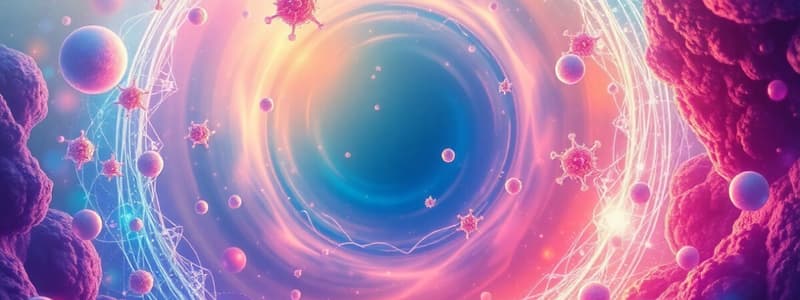Podcast
Questions and Answers
What is temporary hardness primarily caused by?
What is temporary hardness primarily caused by?
- Carbonates and hydroxides of calcium and magnesium (correct)
- Sulphates of heavy metals
- Sodium bicarbonate
- Phosphates from detergents
What happens to bicarbonates when water is boiled?
What happens to bicarbonates when water is boiled?
- They decompose into insoluble carbonates or hydroxides (correct)
- They evaporate into the air
- They remain unchanged
- They convert into salts
Which type of hardness is not easily removed by boiling?
Which type of hardness is not easily removed by boiling?
- Permanent hardness (correct)
- Temporary hardness
- Acid hardness
- Carbonate hardness
Which of the following compounds is produced from the decomposition of calcium bicarbonate upon heating?
Which of the following compounds is produced from the decomposition of calcium bicarbonate upon heating?
What effect do certain salts have on the soap-consuming capacity of water?
What effect do certain salts have on the soap-consuming capacity of water?
What describes the process of osmosis?
What describes the process of osmosis?
What is the main requirement for reverse osmosis to occur?
What is the main requirement for reverse osmosis to occur?
Which of the following is NOT an advantage of reverse osmosis?
Which of the following is NOT an advantage of reverse osmosis?
Which statement accurately describes osmotic pressure?
Which statement accurately describes osmotic pressure?
What is a common disadvantage of reverse osmosis?
What is a common disadvantage of reverse osmosis?
Flashcards are hidden until you start studying
Study Notes
Reverse Osmosis
- Diffusion: Movement of solute particles from high to low concentration.
- Osmosis: Flow of solvent through a semi-permeable membrane from low to high concentration until balanced; pressure developed is osmotic pressure.
- Reverse Osmosis (RO): Solvent flow from high to low concentration under hydrostatic pressure exceeding osmotic pressure.
Advantages of Reverse Osmosis
- Efficient removal of silica at lower costs.
- Membrane lifespan is relatively high.
- Initial capital costs are low.
- Operates effectively at low temperatures.
- Effectively eliminates microorganisms from water.
Disadvantages of Reverse Osmosis
- Generates water waste.
- Removes essential minerals from water.
- Requires approximately 200 psi above osmotic pressure for operation.
Types of Hardness
- Temporary Hardness: Caused by carbonates and bicarbonates of calcium and magnesium, removable by boiling.
- Permanent Hardness: Associated with non-carbonate salts like sulfates and chlorides, which are not removable by boiling.
Temporary Hardness Reactions
- Calcium bicarbonate decomposes into insoluble calcium carbonate on boiling.
- Magnesium bicarbonate decomposes into magnesium hydroxide on heating.
- Reactions can remove hardness and produce soluble soap.
Hard vs. Soft Water
- Hard Water: Does not lather with soap, forms curds due to the presence of calcium and magnesium.
- Soft Water: Easily lathers with soap and contains no dissolved calcium and magnesium salts.
Zeolite Process
- Zeolite Composition: Na₂O·Al₂O₃·xSiO₂·yH₂O, where x = 2-10, y = 2-6.
- Function: Hard water passes through sodium zeolite, replacing calcium and magnesium ions with sodium, thus softening water.
Regeneration of Zeolite
- Zeolite becomes saturated and is regenerated by treating with a 10% brine solution, allowing it to be reused for water softening.
Advantages of Zeolite Process
- Effectively reduces hardness to about 10 ppm.
- Compact equipment, requiring minimal space.
- Automatically adjusts for varying hardness levels.
- Prevents sludge formation.
- Quick and efficient softening process.
Disadvantages of Zeolite Process
- Treated water may contain excess sodium salts.
- Only causes replacement of Ca²⁺ and Mg²⁺ ions, with other acidic ions remaining.
- Not effective for high turbidity water.
Lime-Soda Process (L-S Process)
- Converts soluble hardness-causing impurities into insoluble precipitates for removal through settling and filtration.
Boiler Water Considerations
- Ideal Boiler Feed Water: Should have hardness below 0.2 ppm and specific alkalinity levels for effective steam generation.
Sludge and Scale Formation in Boilers
- Sludge: Loose, slimy precipitates formed from concentrated salts.
- Scales: Hard deposits adhering to boiler surfaces, caused by alkaline earth metals and other impurities.
Prevention Strategies for Scale Formation
- Use of kerosene or tannin to form suspensions.
- Carbonate Conditioning: Prevents scaling using sodium carbonate.
- Phosphate Conditioning: Forms nonadherent precipitates.
- Calgon Conditioning: Addresses hardness effectively.
Boiler Corrosion Causes
- Dissolved oxygen, carbon dioxide, and acids contribute to corrosion, with methods for removal outlined.
Priming and Foaming
- Priming: Wet steam formation that causes water to be carried along with steam, usually due to sudden temperature or pressure changes.
- Foaming: Persistent bubble formation caused by oils or contaminants in water.
Caustic Embrittlement
- Caused by the presence of sodium carbonate converting to sodium hydroxide and causing localized corrosion in boiler materials.
- Prevented through the addition of tannin or replacing sodium carbonate with sodium phosphate.
Studying That Suits You
Use AI to generate personalized quizzes and flashcards to suit your learning preferences.




